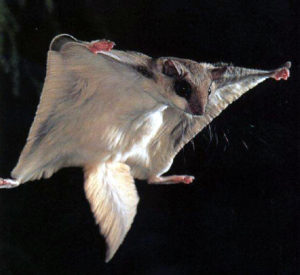 These small tree squirrels actually glide instead fly, but can glide over 80 yards/240 ft (73.2 m). They become pests only when they take up residence in an attic where they can cause odor and damage with their urine and keep people awake with their nocturnal activity; they are of very minor medical concern. They are found throughout the eastern United States and eastern Canada, west to Alaska, narrowly southward throuah Utah.. and also southward through California. This article will be restricted to the northern flying squirrel.
These small tree squirrels actually glide instead fly, but can glide over 80 yards/240 ft (73.2 m). They become pests only when they take up residence in an attic where they can cause odor and damage with their urine and keep people awake with their nocturnal activity; they are of very minor medical concern. They are found throughout the eastern United States and eastern Canada, west to Alaska, narrowly southward throuah Utah.. and also southward through California. This article will be restricted to the northern flying squirrel.
Adults small, with head and body length 5 1/2-6 7/16″ (14-16.2 cm) and tail length 3 1/2-5 1/2″ (8.9-14 cm); weight 1 3/4-6 1/2 oz (49.6-184.3 g). Color brown above and white below. Fur soft and thick. Skull with 22 teeth. Eyes large, black. Body with loose fold of skin between front and hind legs.
The northern flying squirrel has 1 litter each year, with 2-5 young born in May-June; sometimes there is a second litter in the autumn. Flying squirrels have been implicated in human diseases, but direct transmission is rare. Plague has been isolated from a subspecies of the northern flying squirrel in California.
The northern flying squirrel inhabits coniferous and mixed forests. The northern and southern flying squirrels are the smallest of the tree squirrels, are the only nocturnal ones, and are the most carnivorous of the group. The southern flying squirrel feeds on nuts, acorns, seeds, berries, some insects, and bird eggs; they will eat meat if it is available. Some food is stored in the nest chamber and also in tree crotches. The northern flying squirrel feeds primarily on nuts and seeds, but also eats some insects, and probably stores much food for winter use. Southern flying squirrels favor old woodpecker holes as nest sites, but they may build a summer nest of leaves, twigs, and bark.
They will also use the attics of buildings. In the winter, 20 or more may den together. Northern flying squirrels prefer dead trees with numerous woodpeckers holes for nesting, especially in stumps 6-20 ft (1.8-6.1 m) high and those near the top.
Flying squirrels do not truly fly, but they glide through the air. The southern flying squirrel can glide over 80 yards/240 ft/73.2 m. They stretch out their legs, spreading out the fold of skin between the front and hind legs to form a glider wing/sail. While gliding, they are very agile and can turn and change the angle of decent. They land very lightly on all 4 feet. In contrast, flying squirrels are relatively clumsy on the ground.
The key to flying squirrel control is pest identification, exclusion/squirrel-proofing the building, and trapping out any resident squirrels. A thorough inspection beginning about an hour before sunset and into the evening is required to observe activity patterns; binoculars are a must. This is followed by a day inspection to confirm entry points and locate other potential entry points. Knowing the entry point(s) makes it easier to locate any nests.
Exclusion must be thorough. Seal all holes 1/4″ (6 mm) or greater in size with 1/8″ (3 mm) hardware cloth, metal flashing, or other appropriate material, but leave their main entry hole open. If it is not breeding season (April-May or August-September) plus 30 days for the young to become mobile, the remaining hole can be sealed after a few days for adjustment; otherwise, pregnant and/or nursing females and their young will be trapped inside. Seal the hole a couple of hours after they have left around dusk for evening feeding.
To more quickly reduce the population or to remove individuals from within the structure, use mouse-sized wooden-based snap traps, Use peanut butter or nuts on the trigger; pre-baiting is a must. Place the traps along runways between the entrance hole and nesting site. Check these traps daily to re-bait, re-position, and to remove trapped/dead squirrels.
